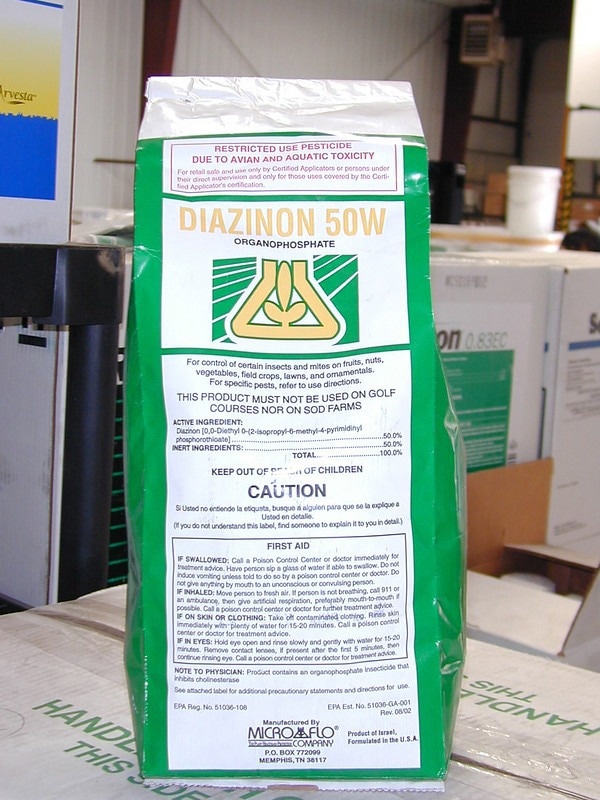To create innovative tests for a variety of chemicals, such as banned pesticides and dangerous, synthetic cannabinoids, scientists have changed proteins that are involved in plants’ natural reactions to stress.
 Diazinon is a banned insecticide that the research team is able to detect with their new plant-hormone-based sensor system. Image Credit: University of California, Riverside
Diazinon is a banned insecticide that the research team is able to detect with their new plant-hormone-based sensor system. Image Credit: University of California, Riverside
Plants generate ABA, a hormone that aids in water storage when there is a drought. The plant uses additional proteins known as receptors to identify and react to ABA. The ability of these ABA receptors to immediately transmit the presence of almost 20 distinct compounds was clearly explained by UC Riverside researchers.
A recent paper in the journal Nature Biotechnology details the study team’s efforts to modify these plant-based molecules.
All sorts of chemicals, including those that are harmful to humans or the environment, frequently need to be found by researchers. Although there are ways to achieve it, they are frequently expensive and need specialized equipment.
It would be transformative if we could develop rapid dipstick tests to know if a dangerous chemical, like a synthetic cannabinoid, is present. This new paper gives others a roadmap to doing that.”
Sean Cutler, Study Co-Author and Professor, Plant Cell Biology, University of California, Riverside
Cutler refers to the issue with synthetic cannabis as “regulatory whack-a-mole.” Authorities have tried to make them illegal in this nation because they send people to the hospital. But before they can be regulated, dozens of new variations appear every year.
Our system could be configured to detect lab-made cannabinoid variations as quickly as they appear on the market.”
Sean Cutler, Study Co-Author and Professor, Plant Cell Biology, University of California, Riverside
Additionally, the study team showed that its testing method can detect organophosphates, which are a class of banned pesticides that are hazardous and perhaps fatal to people. Not all organophosphate pesticides are banned, but being able to easily identify those that are might aid in water quality monitoring without the need for more costly laboratory testing.
The scientists demonstrated the system in lab-grown yeast cells. The team hopes to reintroduce the altered molecules into plants in the future so that they can act as biological sensors. In that situation, a chemical in the environment can produce temperature changes or certain color changes in the leaves.
The important innovation here is the capacity to quickly build diagnostics for chemicals using a straightforward and affordable approach, notwithstanding the work’s focus on cannabinoids and pesticides.
If we can expand this to lots of other chemical classes, this is a big step forward because developing new tests can be a slow process.”
Ian Wheeldon, Study Co-Author and Chemical Engineer, University of California, Riverside
The Advanced Plant Technologies (APT) program of the Defense Advanced Research Projects Agency (DARPA) supported the development of this study through an agreement with the Donald Danforth Plant Science Center.
Scientists from the Donald Danforth Plant Science Center in St. Louis, Michigan State University, and the Medical College of Wisconsin were also on the team. Timothy Whitehead, a chemical and biological engineer at the University of Colorado in Boulder, helped to assist this study.
The capacity of the ABA plant stress hormone to toggle receptor molecules on and off was used by researchers to construct this device. When the receptors are turned on, proteins associated with another protein form a compact structure that can cause outward manifestations, such as glowing. Modern computational methods were employed by Whitehead, a team member, to assist with redesigning the receptors, which was essential to the team’s success.
“We take an enzyme that can glow in the right context and split it into two pieces. One piece on the switch, and the other on the protein it binds to. This trick of bringing two things together in the presence of a third chemical isn’t new. Our advance is showing we can reprogram the process to work with lots of different third chemicals,” Cutler concluded.
Source:
Journal reference:
Beltrán, J., et al. (2022) Rapid biosensor development using plant hormone receptors as reprogrammable scaffolds. Nature Biotechnology. doi.org/10.1038/s41587-022-01364-5.